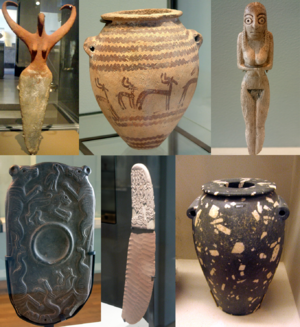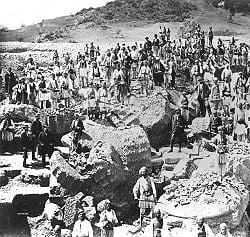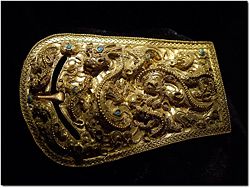Artifact (archaeology)

Artifact - A Definition
In archaeology, an artifact or artefact is any object made or modified by a human culture or group. Often the artifact - or object - is recovered long after the time it served its purpose, through an archaeological endeavor or even by accident or chance. Examples of artifacts from various time periods would include stone tools such as projectile points, pottery vessels, metal objects such as buttons or guns, and items of personal adornment such as jewelery and clothing. Other examples include bone that show signs of human modification, fire cracked rocks from a hearth or plant material used for food. Artifacts give archeologists important information about previous cultures and civilizations. Artififacts not only tell stories about prior ages but they help in dating earth's time periods and in historical record keeping.
Sources of artifacts
In archaeology it is not ony the physical location of a discovery that holds significance, but the context (or setting) as well. And an archaeological context does not only refer to a geographical place, it can also be an event in time which has been preserved in the archaeological record. Multiple fills of soil in a ditch, for example, could imply multiple contexts. By separating a site into basic, discrete units, archaeologists are able to create a chronology for activity on a site and not only describe it, but allow for its interpretation as well.
Artifacts can come from many different sources such as:
- grave goods personal items Buried along with a body
- Hoards
- Votive offerings
- From any archaelogy feature such as a pit, wall, ditch or a midden (a landfill)
Most grave goods recovered by archaeologists consist of inorganic objects such as pottery and stone and metal tools, but there is evidence that organic objects that have since decayed were also placed in ancient tombs. Some of the most famous and well preserved grave goods are those from ancient Egypt, who believed that goods buried in tombs could be used by the deceased in the afterlife.
Middens, dumps which contain human waste, can also contain a variety of archaeological material, including animal bone, feces, shell, botanical material, vermin, sherds, lithics, and other artifacts and ecofacts associated with past human occupation. Middens useful resource for archaeologists who wish to study the diet and habits of past societies. Middens with damp, anaerobic conditions can even preserve organic remains which can be analyzed to obtain information regarding climate and seasonal use.
In archaeology, a hoard is a collection of artifacts purposely buried in the ground, usually with intention to recover them at a later date. Hoarders oftentimes died before retrieving their loot, and these surviving artifacts can sometimes be uncovered by hobbyists with metal-detectors or archaeologists much later.
Hoards provide a useful method of providing dates for artifacts. They can sometimes indicate the degree of conflict or war in an ancient societies. For example, circumstances in 5th century and 6th century Britain spurred the burial of hoards.
A votive deposit or votive offering is an object left in a sacred place for ritual purposes. Examples would include: A contemporary example of a votive offering would be the Catholic church's candles that members of the church not only light but deposit coins or donations into.
Artifacts are distinguished from the main body of the archaeological record such as stratigraphic features, (which are nonportable remains of human activity, such as hearths, roads, or deposits and remains) and from biofacts or ecofacts. The are objects archaeological interest made by other organisms, such as those from seeds or animal bones.
Natural objects which have been moved but not changed by humans are called manuports. Examples would include seashells moved inland or rounded pebbles placed away from the water action that would have fashioned them.
These distinctions are often blurred; for instance, a bone removed from an animal carcass is a biofact, but a bone carved into a useful implement is an artifact. Similarly there can be debate over early stone objects and whether they are crude artifacts made by humans or are instead naturally occurring phenomena that only appear to have been used by humans.
Use of artifacts in archaeological analysis

identification, classification, quantification, data manipulation, and analysis- ref 2 discovery, typology, dating, conservation, and decoration -ref 4
Artifacts are often called "finds" when handled during archaeological excavation. Artifacts are related to the archaeological record by their position defined by the Archaeological context they are discovered in. This is important for Seriation and relative dating analysis and is closely related to work post excavation with the use of a Harris matrix created during excavation. An analysis of finds is often made during excavation for the purpose of spot dating, which is a process of assessing dates of contexts being excavated. It is used as a form of confirmation concerning phasing and highlighting any potential for further discovery on a given site as it progresses. Spot dating tends to rely on pottery typology. This pottery dating analysis was pioneered by 19th century archaeologists such as Georg Loeschcke. Apart from dating and supporting the process of excavation, artifacts lend themselves to a host of post excavation disciplines.
Artifacts and controversy
The degree to which artifacts represent the social groupings that created them is a subject over which archaeological theoreticians disagree. Focusing on the artifact alone can produce very enlightening work on the object itself but but such scrutiny can ignore surrounding factors which may shed further light on the society being studied. Traditional museums are often criticised for being too artifact-led, that is for displaying items without any contextual information about their purpose or the people who made them.
Artifact Trivia
Examples of interesting artifacts abound. They can be find in museums like the Natural History Museum in New York or the Smithsonian Museum in Washington D.C. A popular touring exhibit in the United States in 2008 was an artifact collection of King Tutankhamen's royal burial treasures.
Other artifacts told about in the book are:
- George Washington's false teeth
- a sacred Black Stone revered by Muslims in Mecca
- Voyager 2's gold-plated phonograph record for extraterrestrials
- Anne Frank's diary
- the Wright brothers biplane
- the fake gun that John Dillinger used to bluff his way out of an Indiana jail.
Besides their usefulness to science; artifacts can be a testimony to human aspiration, obsession, and belief. If, in telling a story, a picture is "worth a thousand words" as the expression goes than an artifact is worth even more. probably too hokey to say, right?
Notes
ReferencesISBN links support NWE through referral fees
- Margolis, Eric, and Stephen Laurence. 2007. Creations of the mind: theories of artifacts and their representation. Oxford: Oxford University Press. ISBN 9780199250981
- Ewen, Charles Robin. 2003. Artifacts. Archaeologist's toolkit, v. 4. Walnut Creek, CA: AltaMira Press. ISBN 075910400X
- Mills, Elizabeth Shown. 2007. Evidence Explained: Citing History Sources from Artifacts to Cyberspace. Baltimore, Md: Genealogical Pub. Co. ISBN 9780806317816
- Kipfer, Barbara Ann. 2007. Dictionary of Artifacts. Malden, MA: Blackwell Publishing. ISBN 1405118873
- Rachlin, Harvey. 1996. Lucy's bones, sacred stones, & Einstein's brain: the remarkable stories behind the great objects and artifacts of history, from antiquity to the modern era. A Henry Holt reference book. New York: H. Holt. ISBN 0805039643
External Links
Credits
New World Encyclopedia writers and editors rewrote and completed the Wikipedia article in accordance with New World Encyclopedia standards. This article abides by terms of the Creative Commons CC-by-sa 3.0 License (CC-by-sa), which may be used and disseminated with proper attribution. Credit is due under the terms of this license that can reference both the New World Encyclopedia contributors and the selfless volunteer contributors of the Wikimedia Foundation. To cite this article click here for a list of acceptable citing formats.The history of earlier contributions by wikipedians is accessible to researchers here:
The history of this article since it was imported to New World Encyclopedia:
Note: Some restrictions may apply to use of individual images which are separately licensed.
